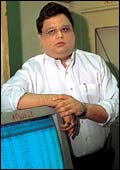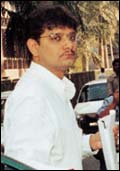|
The
numbers are going d-street's way. Bombay stock Exchange's Sensex
breached its 26-month high of 3721 on July 14, before closing at
3686.34 on July 15, the day this magazine went to press. The first
number is around 25 per cent higher than the low of 2997.87 it touched
barely three months ago, on April 11. In the same period National
Stock Exchange's broad-based index, S&P CNX 500 is up 32 per
cent. And the BT 50, India's only free-float index, up 29.3 per
cent. On BSE that's some Rs 1,87,402 crore of market value added
in 55 trading days.
The finance ministry, edgy after a series of
annual stockmarket scams, asked India's capital markets watchdog,
Securities and Exchange Board of India to investigate whether this
bull-run had speculative origins. But with SEBI Chairman G.N. Bajpai
declaiming that the rally is based on fundamentals, things couldn't
be better. One, there's a mini-boom of sorts on. And two, it's based
on tangibles such as improved corporate performance, a good showing
(to date) by the monsoon, and improved industrial growth. Indeed,
the fundamentals of the economy have been healthy enough for Centre
of Monitoring Indian Economy (CMIE) to up its estimates for GDP-growth
in 2003-04 to 6.5 per cent.
In a trend that is at once a cause for the upturn in the stockmarkets
and a fallout of that, Foreign Institutional Investors (FIIs) are
back. In June, FIIs pumped in $547 million (Rs 2,581 crore) into
the market; till July 14, they had invested an additional $362 million
(Rs 1,695 crore). All told, between January 1 and July 14, 2003,
their investments in the market is a whopping $1,605.4 million (Rs
7,566 crore); in 2001, the best year for FII investments in the
market, the number was $2,671 million (Rs 12,821 crore).
One reason for that could be that emerging
markets are back to being 'in' with FIIs. And at present valuations,
several Indian stocks are a steal.
The quantum of investment by FIIs has led to
reports about hedge funds operating in India. Although they cannot
invest directly in India, they can do so through FIIs. The latter
buy shares on behalf of the former and issue them contracts, termed
participatory notes or P-notes. D-street buzz has it that between
40 per cent and 50 per cent of FII money coming in now can be traced
back to P-notes. Since hedge funds are, by their very definition,
focused on the short-term, this doesn't bode well for the Indian
market. Unless, of course, the market can keep up its momentum.
Several investors believe it can. There's Rakesh
Jhunjhunwala the speculator-trader who has been waiting for a bull
market for the past year and half. "I am bullish, not by valuations,
but by fundamentals," says Jhunjhunwala whose preferences run
to PSU- and pharma stocks. Another bull from the late Harshad Mehta's
era, Nemish Shah, Director, Enam Financial Services, has emerged
from hibernation. Don't make a balance sheet every year, he urges
investors. "Look at the long-term picture." Last year
the average EPS (Earnings Per Share) for the Sensex was Rs 288.
This year, Enam expects it to be Rs 330.
Jhunjhunwala and Shah may well turn out to
be right: the current edition of the stock market's rally is broad-based;
even mid-cap and small-cap stocks are showing signs of upward movement.
Still, the scars of previous bull runs that petered out or turned
out to be scam-driven remain. Arun Kejriwal, a broker on D-street
is worried by the movement in penny stocks this early in the rally
(in a sustained rally, this takes some time). And the buzz on the
Street has it that Ketan Parekh, the bull behind the 2001 stock
market scam is back. Our recommendation: things look good, but it's
still a case of Caveat Emptor.
-Roshni Jayakar
 |
| Jhunjhunwala: Fundamentally bullish |
The Once & Forever Bulls
Two who see good things ahead.
Both, Nemish shah
and Rakesh Jhunjhunwala have always been bulls. Shah was bullish
on Reliance, ACC, and L&T in the 1992 bull-run. Then, he seemed
to have gone cold to the markets (even to the tech wave), although
he insists that he was "fully invested" in the markets
all along. Jhunjhunwala is a speculator who believes that several
Indian scrips are undervalued. In February this year, he assured
BT that the Indian market was on the threshold of a sustained bull
run. Now, both Shah and Jhunjhunwala are out there, out-and-out
bulls. Interestingly, both advocate a medium-term investing strategy.
Take a tip from them: buy and hold, then.
 |
| Ketan Parekh: An encore? |
Is KP back?
No one knows for sure.
To some people
it is enough evidence that the bull who moved the markets in 2000
and 2001 is back. To others, it is inconclusive evidence that could
well be a mere coincidence. We're referring to the increase in the
prices of Ketan Parekh's favourite stocks. The HFCL, DSQ Software,
and Pentamedia scrips, have all moved up marginally. That could
well be the result of a secular market rally-as we mentioned even
small-cap and mid-cap stocks been part of the recent revival on
the bourses-although it really is much more sensational to attribute
the interest in these scrips to KP's return.
Dropped
Call
No, there are no easy answers to this one.
 For
back-seat execs caught in one of Delhi's or Mumbai's ubiquitous
traffic snarls, the mobile phone provides an escape pod-away from
the gridlock and into the rarefied realm of work. Now with 2.1 million
subscribers in Delhi and 1.9 million in Mumbai crowding the airwaves,
or the 6.2 to 8 Mhz (per operator) of spectrum available, that option
is either not available or, when available, often not of a quality
that facilitates seamless two-way conversations. For
back-seat execs caught in one of Delhi's or Mumbai's ubiquitous
traffic snarls, the mobile phone provides an escape pod-away from
the gridlock and into the rarefied realm of work. Now with 2.1 million
subscribers in Delhi and 1.9 million in Mumbai crowding the airwaves,
or the 6.2 to 8 Mhz (per operator) of spectrum available, that option
is either not available or, when available, often not of a quality
that facilitates seamless two-way conversations.
The problem isn't as acute in other cities,
although it is but a matter of time before that happens: Last year,
India added close to 6 million subscribers to the existing base
of 6 million; this year, it will add another 12 million. Companies
providing cellular telephony services lay the blame for the gridlock
squarely at the door of the government, which they claim is dragging
its feet over releasing more spectrum.
The government has said that it will release
more spectrum, although that will take some time. In the meantime,
it says, operators can maintain the quality of service by investing
in network-upgradation. The Cellular Operators Association of India
claims that with the industry's average revenue per user (ARPU)
being lower than what it costs to serve a subscriber, none of the
operators can do that. Besides, argue some operators, they have
already done what they could and point to the fact that cell-sites
are located as close as 150 metres apart in high-traffic areas as
evidence to this. The man in charge of regulating India's telecommunications
market, Telecom Regulatory Authority of India (TRAI) Chairman Pradip
Baijal is having none of that. "I do not believe spectrum is
a constraint at present," he says. "Maybe later, but not
now". Basic operators who use CDMA technology to offer 'limited
mobile' services claim their technology uses the spectrum more efficiently.
And the calls continue to drop.
-Vandana Gombar
RE-INDEX
Is It Time To Redo The Sensex?
The sensex, its detractors
claim, is slow to capture upturns and downturns. We tend to agree
(which is why we have our own index). Here's why: one, it excludes
small- and mid-cap stocks where most action happens; two, it is
weighted in terms of market capitalisation and movements of a few
heavyweight stocks can make it swing either way; and three, BSE
hates making changes in it. "Index composition is reviewed
on a quarterly basis," explains Dr Bandi Ram Prasad, Chief
Economist, BSE. "It is a widely-tracked index and changes are
made only when necessary." Last year saw two changes in the
index: ICICI Bank replaced ICICI and HDFC, Reliance Petroleum; M&As
made both changes imperative. With the country's largest carmaker
and the country's largest cellular telephony company now listed,
bse could do worse than be a little more adventurous.
-Narendra Nathan
|

